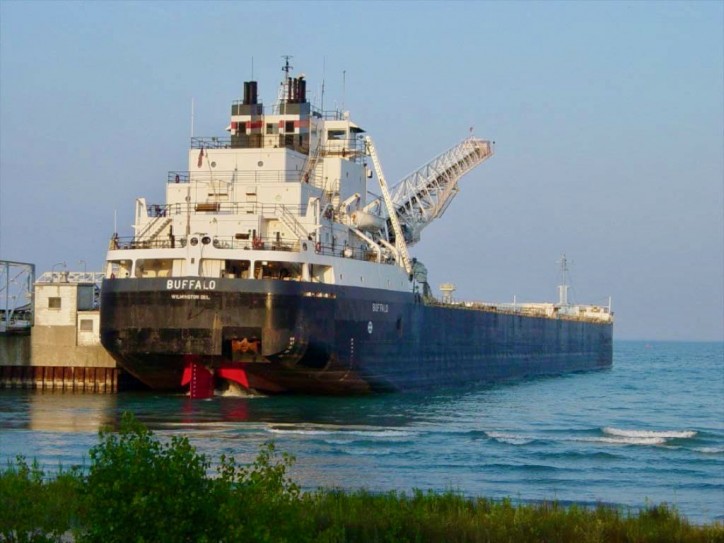The Soo Locks’ critical role in the national defense of the United States has prompted the House of Representatives to direct the U.S. Army Corps of Engineers (Corps) to accelerate their project to build a second Poe-sized lock at Sault Ste. Marie, Michigan. The Committee on Armed Service’s report on the National Defense Authorization Act of 2019 (HR5515), which passed the House Monday by an overwhelming majority of 351-66, “urges the Commander, U.S. Army Corps of Engineers, and all involved executive branch agencies to expedite necessary reviews, analysis, and approvals in order to speed the required upgrades at the Soo Locks.”

The Committee Report notes the Soo Locks are the only waterway connection from Lake Superior to the Lower Great Lakes and expresses “concerned that of the two current operational locks, only the Poe Lock is large enough to accommodate the 1,000 foot carriers necessary to transport a majority of the iron ore used in domestic steel production … [That] lock is at the end of its 50-year useful lifespan….”
Steel is the backbone of national defense and the Committee Report emphasizes that “a failure at the Soo Locks would have drastic impacts on national security, in that the United States iron mining-integrated steel production-manufacturing supply chain is dependent on the Soo Locks, and there is no redundancy. Indeed, such a failure would cripple steel production that is used for national defense priorities.”
In 2017, the Poe Lock handled virtually all of the 39 million tons of iron ore passing through the Soo Locks destined for American steelmakers.
The Soo Lock language was sponsored by Congressman Paul Mitchell (R-MI). “Rep. Mitchell has been a tireless advocate for a second Poe-sized lock and Great Lakes shipping in general,” said Jim Weakley, President of Lake Carriers’ Association, the trade association representing U.S.-flag vessels operators on the Great Lakes. “Michigan would be the state hardest hit by a lengthy failure of the Poe Lock. A Department of Homeland Security study determined a 6-month closure of the Poe Lock would push Michigan’s unemployment rate to nearly 23 percent. Nationwide, 11 million Americans would lose their jobs. We must build a second Poe-sized lock as soon as possible.”
“I’m proud that my first action on the House Armed Services Committee was reaffirming the national security importance of the Soo Locks,” said Mitchell. “Nearly all domestic iron ore – which is required for certain steel production, a substantial part of our economy and essential for national defense – travels through the Soo Locks. Steel production critical to our nation’s military and millions of American jobs are dependent on the Soo Locks, and there is no redundancy or alternatives to the locks. That’s why I am glad the whole House of Representatives is urging the US Army Corps of Engineers, and all involved executive branch agencies, to expedite necessary reviews, analysis, and approvals in order to speed the required upgrades at the Soo Locks.”
Congress authorized construction of a second Poe-sized lock in 1986, but the project stalled due to an inaccurate Corps estimate of its benefits. The Corps has acknowledged that the initial benefits estimate was based on the false premise that the railroads could move the cargo stranded by a failure of the lock and is recalculating it. An Economic Reevaluation Report is expected soon and the updated benefits estimate should enable the project to be funded.
President Trump recently pledged his support for a second Poe-sized lock. Speaking to a rally in Washington Township, Michigan, on April 28 Trump stated “The Soo Locks are going to hell. You know that, right? And we’re going to get them fixed up.”
Construction of new locks at the Sault Ste. Marie, Michigan, has often been tied to national defense. The now obsolete Davis and Sabin locks were built during World War One. The MacArthur Lock was constructed at a furious pace to meet demand for iron ore during World War Two and 10,000 troops were stationed at the “Soo” to guard the Locks. Work began on the Poe Lock in 1961, the height of the Cold War.
The importance of iron ore to national defense was further underscored when just 10 days after the Japanese attack on Pearl Harbor Congress appropriated $8 million of the construction of a near polar-class icebreaker for the Great Lakes. That vessel, the MACKINAW, was launched in 1944 and served the Lakes with distinction until 2006.
Source: Great Lakes Seaway